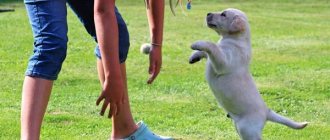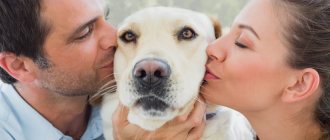How to understand that a dog wants to go to the toilet? This question interests many novice dog breeders who have made a faithful four-legged friend in city apartments.
Our smaller brothers cannot speak a language that we understand, but they can express their emotions and feelings with their gaze, certain poses, voice, tail, and facial expressions. You just need to carefully monitor your pet’s habits, analyze your dog’s behavior in various situations, and over time you will easily learn to understand what your beloved dog wants and feels.
Why does a dog pee when it sees you?
When dogs are excited, they are more likely to wag their tail.
They may also leave behind a small puddle of urine. This is an instinctive, physical response called submissive urination and is normal in dogs young and old.
Submissive urination usually occurs when a dog is feeling excited, shy, anxious, or fearful. This also happens when a dog wants to acknowledge the dominance of another - for example, recognizing you as its owner.
Submissive urination is equally common in females and males, especially in puppies. Over time, dogs usually outgrow this behavior.
If your dog urinates when someone comes up and says hello, when he is in trouble or scolded, when he crouches or shows his belly, or when he hears loud noises, these are signs that your dog's inappropriate urination is submissive.
Training your dog to stop can help stop this process.
Veterinarian advice
If a person loves a dog, it will definitely reciprocate. Of course, one cannot ignore and silently remove puddles and piles from it; it is necessary to build a correct line of behavior.
Veterinarian advice:
- if the baby has done something dirty, then it is advisable to talk to him in a stern tone;
- when the dog starts looking for a place to shit, you need to drop something or hit it to distract attention and quickly take it to the toilet;
- While walking, it is recommended to find a friend for your pet. He will become an example of behavior.
- It is advisable to play with the dog in the fresh air until its intestines and bladder are full.
If a male dog cannot be trained, then perhaps it is time to castrate him or breed him. As an alternative, drugs are used to regulate sexual heat.
Many families adopt a dog for fun and do not train it. Therefore, problems begin with the animal’s behavior and toilet. But if you systematically deal with the animal, then these problems can be avoided.
Medical Causes of Submissive Urination
If you suspect your dog's urinating is not due to submission, it is important to rule out other causes before attempting to correct the behavior.
Your dog making a puddle could be a symptom of something your dog can't control.
Reasons may include:
Changing your diet. If your dog eats or drinks more or less than usual, his bathroom habits will also change.
Urinary incontinence. Your dog may not be able to "hold it" when he needs to pee. They may also have a weak bladder.
Urinary tract infection (UTI). A UTI can cause your dog to pass urine without even realizing it.
If your dog is having problems with inappropriate urination, talk to your veterinarian to see if testing or treatment may be needed to rule out underlying medical causes.
What to do if your dog craps at home
Often dog breeders complain that a dog that walks on the street continues to crap in the house or apartment. Such behavior does not mean that the animal is doing evil and can be caused by:
- chronic diseases (nephritis, pyelonephritis, cystitis);
- severe stress, fear, fright;
- inflammatory processes in the organs of the genitourinary tract;
- a mental state in which dogs do not fully control themselves and cannot control their urges.
Short walks, loneliness, lack of attention, a restless environment in the house, hypothermia can also cause a dog to relieve itself at home. To wean your dog off this bad habit, you need to understand the situation and analyze what caused this behavior.
Submissive urination as a behavioral problem
Puppies and young dogs are more likely to urinate inappropriately because they have not learned to control their urge to go to the toilet.
These dogs act on instinct, so it is a behavioral problem, not a medical one.
Several factors may contribute to this:
Age. If your dog is younger than 12 weeks old, he is more likely to urinate as a sign of submission to show that he knows he is not the leader.
Puppies usually outgrow this. But puppies may also not yet have the ability to control their urine. Through home training, they will learn the signs of needing to go to the toilet and can improve their ability to keep it down.
Partial homeschooling. If you adopt a dog older than 12 weeks, it may simply not be trained properly. This includes not knowing when and where to urinate.
The dog you adopt may not always understand the rules in their new home, which can lead to submissive urination due to insecurity.
Fear from past bad experiences. Some dogs have a history of inappropriate punishment and will try to show that they recognize you as the leader in order to avoid punishment.
Fear of separation. Your dog misses you when you are not home. If they think you're going to leave soon, they may urinate due to emotional distress over being abandoned.
When you get home, your dog may urinate out of excitement, which is different from submissive urination but also related to his uncertainty when you leave.
Dominant urination. Another closely related but distinct behavioral problem to watch for is urine marking.
Many dogs urinate to mark territory and try to express dominance, which is the opposite of submissive urination. This tells other dogs that the person or property “belongs” to them.
For example, my Doberman carefully describes all the new things that appear in the yard, leaving his mark on them so that everyone knows that he is here and the thing belongs to him.
Since instinct causes urination to occur as a physical response, training your dog can make a difference.
When should you train a puppy to go outside?
Some of the most common questions that interest novice dog breeders are: “How to understand that a dog wants to go to the toilet?”, “How many times a day should you walk your dog?” Therefore, this article will provide detailed information that will answer these questions.
Regardless of whether the dog lives in a city apartment or in a private house, after the end of the adaptation period, you need to gradually begin raising your pet. And you need to do this regularly, reinforcing useful skills day after day. The dog must know and understand well what is allowed and what is not.
In order for the dog socialization process to be successful and as quickly as possible, you must understand your pet's intentions. It is not necessary to have extensive experience communicating with animals or have developed intuition. Rely on your own observations, communicate more often and watch your beloved dog. Until the end of the quarantine period after vaccination, the puppy will relieve itself at home for about two months, so be patient and get ready to clean up piles and puddles. In this case, you can calmly train your dog to relieve himself in the same place. So, for example, a dog can wear disposable diapers or use a litter tray.
Training a Dog to Stop Submissive Urination
As your dog ages, he will outgrow the urge to urinate submissively. Training dogs at a young age can help them learn faster.
Dogs usually cower or drop to their feet when they feel the urge to submissively urinate.
They can also:
- Raise your front paws
- Press your tail
- Press your ears back
- Lick
If you notice your dog acting this way, redirect his attention immediately.
Chemical and folk remedies
If regular trips outside and visits to the litter box do not help to wean your dog from peeing in the wrong place in the house, you can arm yourself with special means. They are sold in a wide range in veterinary pharmacies and pet stores. To choose the right product, it is recommended to consult and get advice from a specialist. He will tell you how to use it correctly and when to expect results.
The most popular means:
- Antigadin;
- Fresh;
- Puppy Trainer;
- Smart spray;
- Ordagone, etc.
Expert opinion
Anna Abramenko
An avid dog lover. Experience in veterinary medicine since 2009.
Ask a Question
They contain substances that cause urine to dissolve and odor to disappear. The effect occurs 1-2 hours after spraying. It is necessary to select a different product for each pet, since not everyone reacts equally to the repeller.
If you don't trust chemicals, you can treat the carpet and floor with household products from the kitchen cabinet.
- Medical alcohol. After applying it, the dog will avoid the scalded area for a long time. It is recommended to place swabs with alcohol around the perimeter of the apartment.
- Vinegar. The pungent smell scares the dog away and forces him to look for a new toilet.
- Soda. It is enough to sprinkle it on a puddle, and it will neutralize the urine.
- Citrus. To wean a puppy from shitting, fruit skins are laid out around the house, and the marked areas are treated with their juice.
It is recommended to be careful when handling folk remedies so as not to harm your pet. Too aggressive solutions and products can burn the nasal mucosa.
What not to do?
When training your dog to stop urinating submissively, your commands should be positive, consistent, and encouraging.
Don't frown or get angry at your dog. This negative response can frighten or confuse your dog, which can worsen his behavior.
Don't make angry or frustrated comments. It can also frighten or confuse your dog, causing him to continue to urinate as a sign of submission. Dogs respond well to positive reinforcement.
Don't avoid interacting with your dog during episodes of submissive urination. If you simply walk away, your dog will not understand your reaction to this behavior. Instead, try to redirect their attention and build confidence by using commands they know.
If you think you need help training your dog to stop this unwanted behavior, consider contacting a dog trainer who can help you learn more about submissive urination.
Toilet for an adult pet – what problems should you be wary of?
The practice of veterinarians shows that those four-legged animals that do not have to endure are in better health. Due to the inhibition of urination, the following can be expected:
- increased load on the kidneys and organs of the genitourinary system;
- development of urolithiasis - occurs as a result of regular congestion in the bladder and inhibition of the urge to urinate.
If an adult pet comes into the house and has not previously been accustomed to walking and living in apartments, the owner will most likely encounter “puppy embarrassment.” But don’t be scared and immediately give up the idea of taking the poor fellow into your home - there will be difficulties, but they can be overcome.
Adults get used to the new daily routine faster, they are more collected, less playful and less likely to be distracted by any irritants. However, a dog is capable of hiding its desires - it will not always spin around in place, whining and worrying, like a puppy, although such behavior is quite possible.
If the dog does not ask to go outside, you should pay attention to the following signs:
- the pet is worried and cannot find a place for itself;
- actively sniffs the surrounding area;
- spins in one place;
- moves quickly from one corner to another.
And even if a pet comes to the door, whines or scratches the surface, this is not always a signal that he wants to go to the toilet. Most pets love walks, because they are accompanied by games, activities on the playground, communication with the owner and other four-legged animals.
How to properly create a walking schedule for an adult dog? First of all, you need to focus on the duration of food digestion, on average it is 6-8 hours. The dog receives 2 meals a day, and it is advisable that this happens at the same time - in the morning and evening, 6-8 hours before walking. If the pet begins to wake up the owner too early and demands to take him outside, the feeding diet should be adjusted.
How to train a dog to use a litter box
How to make a dog pee in the litter box? Organize the puppy's living space in a visible place away from the passage. Follow the routine - bring your baby to the tray after waking up and eating. Talk to your pet, stroke it, do not hold it by force, instead gently return it to its place when trying to escape, and do not let it leave until it has done its business. Reward with praise and treats, do not hit or scold.
When you catch the puppy in the act, say “ugh” loudly and scold him. If you are late, remove the urine from the floor and wash the surface thoroughly. Before doing this, you can dip a piece of toilet paper in the feces and place it in the tray. If you are away for a long time, place several trays around the apartment.
The dog must remember the sequence: if he did something wrong with the tray, he received a condemnation in response. There is no point in punishing the puppy for the consequences, otherwise he will begin to hide traces of the crime, or look for the darkest corner in the house.
What kind of dogs is the litter box suitable for?
The tray is not suitable for all dogs due to their breed's temperament and intellectual abilities. Decorative breeds best demonstrate the skill of going to the litter box:
- Yorkshire Terriers;
- toy terriers;
- Japanese chins;
- Pekingese;
- Pomeranians;
- dachshunds;
- miniature poodles;
- Chinese Crested;
- Pugs.
Why doesn't the dog go to the litter box?
Reasons for refusing to go to the litter box:
- poor location of the toilet;
- distracting items on the floor, including rugs and runners;
- absent-minded attention and the ability to move freely around the apartment.
Build a home enclosure for the puppies and place a tray there. The animal simply will have no choice. The fewer distractions, the higher the likelihood of choosing a litter box as a toilet.
How to choose the right litter box for your dog
When purchasing a tray, consult with the seller and take a closer look at the future toilet in the store. Remember that puppies grow quickly, so you need to take the tray as they grow. A tray that is too small will most likely not be liked by the dog, because he needs space.
Dog trays are made in the form of a plastic pallet, or galvanized metal is used for production. The bottom is covered with a diaper, rubber mat, lattice, and artificial grass. The smaller the dog, the lower the sides of the tray should be. For example, a toilet without sides is suitable for a toy terrier.
For male dogs, models with a post are produced to prevent marks on furniture and walls.
There are also trays on sale with clamps for securing the substrate.
Reference. As a bedding, you can use a rubber covering with grooves. Dogs rarely go to sawdust, silica gel and clay; they do not have the habit of burying excrement, as cats do.
How to stop going to the toilet at home
An important part of training is to get the dog to stop using your home for sanitary purposes. The following tips will help:
- Lock your puppy in a crate at night and while you are away. As already mentioned, the animal does not go about business where it sleeps. Accordingly, locking him in a limited space, in fact, you leave him no choice but to endure. However, the cage should under no circumstances be an alternative to learning! Don't put your dog there too often or for too long. Your puppy needs you, your care and physical activity. If, while in a crate at night, the dog begins to howl, take it outside. Although this behavior may also mean that the pet simply needed your attention.
- Carefully clean areas already “marked” by the puppy, using appropriate products from pet stores. Unlike ordinary detergents, specialized ones will completely remove the odor. Animals tend to return to the place where they have already arranged a toilet for themselves, so do not give your pet unnecessary temptations.
If possible, it is better to remove carpets for a while, as it is very difficult to remove odors from them.
- If you find excrement in the house, do not throw it away immediately - take it with you to the sanitary exit, put it in the right place and bring the dog to smell it. This will help her go to the toilet outside.
- If you catch your puppy doing things around the house, don't yell at him. Instead, gently interrupt, you can say “No, no!”, clap your hands. After that, put on a leash and go outside. Don't forget to reward your pet when he finishes what he started.
The popular method of “poking” pets with their muzzles is their “mistakes”. This is a completely wrong approach and will not lead to the desired results. Also, you should not punish puppies if they were not patient or made a mistake, for example, during the game. Like children, they still have little bladder control (dogs begin to do this at 4-6 months). If you punish for “incidents,” the puppy understands that you are unhappy, but will not be able to change its physiology. Therefore, there is a high chance that he will simply begin to be afraid of you and choose more secluded corners for sanitary purposes.
What else affects a puppy's behavior?
Body language depends not only on the health of the animal, but also on its mood and the fulfillment of its needs. And if you are sure that your puppy is healthy, but is behaving unusually, it may be due to psychological reasons.
“Bad habits” can be different: the puppy chews on the owner’s things, howls alone, shows cowardice, picks up and eats garbage on the street. However, most often they are all caused by previous experience, lack of physical and emotional stress and weakness of the dog’s nervous system.
To prevent this, do not create situations for the manifestation of bad habits: do not let the dog get overexcited, switch attention to yourself, and always keep the puppy busy with new activities.
The appearance of a puppy in the apartment
The baby is brought into the apartment and does not yet understand that peeing and pooping in the house is prohibited. For the first months, such dogs must be quarantined due to the vaccination regime. Therefore, pets develop the habit of shitting on the floor. When it's time for a walk, the puppies may not relieve themselves outside, but do so only upon returning home.
Note! In small puppies, the urinary system is not yet sufficiently developed. The pet will not be able to withstand an interval between walks of more than 8 hours. Due to long patience, the baby will simply relieve himself on the floor.
What other reasons could cause a puppy to shit on the floor:
- Puppies, like children, cannot be left alone for a long time; if they lack attention, they begin to crap as a sign of dissatisfaction;
- puppies may pee due to stress, a change of environment, or after the arrival of new people;
- switching to dry food can cause problems with the urinary system and, as a result, incontinence;
- during the first visits to the street, the puppy may catch a cold, monitor the baby’s condition after each walk.
Before stopping a dog from crapping in an apartment, owners must follow several steps. Determine where your dog most often leaves puddles. Blot the puddle with cloth or paper and place the tray in its place. Place the fabric inside. If your puppy often shits on furniture, special repellents will help deal with this.
How to stop a dog from crapping in the apartment
The next step is to fix the place for the toilet in the baby's memory. Take your dog there immediately after eating or after long periods of play. It is important that urine-treated cloth or paper be kept there at all times. This way, the puppy will quickly understand which place is reserved for the toilet and will begin to visit it himself.
Check out: A dog for an apartment and a child
Congenital anomalies of the ureter and urethra
The main symptoms are fluid leakage immediately after birth, which occurs involuntarily. This process occurs around the clock, so soon an infection and many small ulcers form around the genitals.
This is a common problem in puppies, breeds bred with a mixture of related ties. In most cases, this is due to the so-called through structure. The bladder does not participate in accumulation, so the sphincter does not work, although it is present in the body. The animal can only squeeze it a little by force of will, sending a signal from the brain. This will reduce the flow, but will not fix the problem. Constant tension is very tiring, and the solution to the problem is only possible through surgery.
At what age should you toilet train a dog?
The easiest way to toilet train a puppy is 4-5 months old, but it is recommended to start the process at 2 months. Many owners try to teach this to their month-old ignorant babies, but this is initially a disastrous idea. Dog handlers advise first establishing a trusting relationship with your pet, and then developing its social skills.










